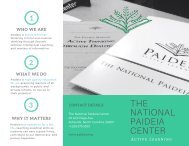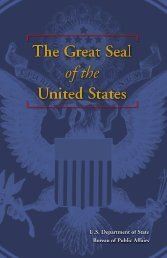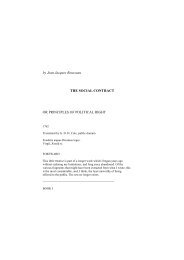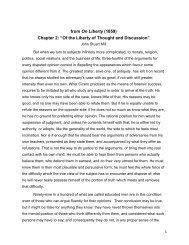On Liberty7.17.15
Create successful ePaper yourself
Turn your PDF publications into a flip-book with our unique Google optimized e-Paper software.
from <strong>On</strong> Liberty by John Stuart Mill<br />
High School / Social Studies<br />
Authority, Dialogue, Freedom of Thought, History, Truth<br />
Have participants write a short, spontaneous response to the following question: How<br />
does one determine the truth?<br />
Ask participants to take part in the following “Opinion Corners” activity:<br />
1. Post signs in the four corners of the classroom: Strongly Agree, Agree, Disagree,<br />
Strongly Disagree.<br />
2. Write on the board the following quote from the text: “There is no necessity for<br />
mankind to know and understand all that can be said against or for their opinions”<br />
3. Have participants move to the corner that reflects their response to this statement.<br />
4. Give participants three to five minutes to discuss in their corners why they chose that<br />
response. Have each group select a spokesperson to share their ideas.<br />
5. Each spokesperson in turn summarizes that group’s thinking.<br />
6. (optional depending on time) Have participants spend about 5 minutes expressing<br />
the counter argument in writing.<br />
Ask participants to scan the document and discuss what they anticipate in the reading.<br />
Briefly discuss the title. Label the paragraphs (A & B) and number the sentences (A=11;<br />
B=9) in the text. Read the whole text aloud and slowly.<br />
Create a list of unfamiliar words (including: forensic, Cicero, refutations,<br />
Inculcate, etc.) on the board. Have teams define these terms and share with the whole<br />
group, while all note definitions on their copies of the text.<br />
1
Share the following as appropriate: John Stuart Mill (1806 – 1873) was a British social<br />
philosopher. He married his long-time friend, Mrs. Harriet Taylor and with her was an<br />
advocate of women’s rights. He wrote on politics and philosophy, including the very<br />
influential <strong>On</strong> Liberty (1859), —addressing the nature and limits of power that can be<br />
legitimately exercised by society over the individual.<br />
Give time for participants to read the text, a second time, independently. State that the<br />
purpose for their second read is to come to a better understanding of the key points.<br />
Give instructions for marking the text by: 1. putting exclamation points next to 3<br />
sentences that you most strongly react to (either in agreement or disagreement); put a<br />
question mark next to at least one point that you are unsure about; and if possible, note<br />
an example from your life next to at least one point.<br />
“A Paideia Seminar is a collaborative, intellectual dialogue about a text, facilitated with openended<br />
questions. The main purpose of seminar is to arrive at a fuller understanding of the<br />
textual ideas and values, of ourselves, and of each other.<br />
“I am primarily responsible for asking challenging, open-ended questions, and I will take a<br />
variety of notes to keep up with the talk turns and flow of ideas. I will help move the discussion<br />
along in a productive direction by asking follow-up questions based on my notes.<br />
“I am asking you to think, listen, and speak candidly about your thoughts, reactions, and ideas.<br />
You can help each other do this by using each other’s names.<br />
“You do not need to raise your hands in order to speak; rather, the discussion is collaborative in<br />
that you try to stay focused on the main speaker and wait your turn to talk.<br />
“You should try to both agree and disagree in a courteous, thoughtful manner. For example,<br />
you might say, ‘I disagree with Joanna because…,’ focusing on the ideas involved, not the<br />
individuals.<br />
“Now, please reflect on how you normally participate in a discussion as a group. What goal can<br />
you set for yourself that will help the flow and meaning of the seminar?<br />
2
“Please consider the list of personal participation goals – either on the Speaking and Listening<br />
Checklist or on the board.”<br />
To speak at least three times<br />
To refer to the text<br />
To ask a question<br />
To build on other’s ideas<br />
“Is there one that is relevant for you? Please choose one goal from the list or that you feel is<br />
best and commit to achieving it during the discussion we are about to have… write down (or<br />
circle) your personal goal.”<br />
For this seminar, I will suggest our group goal (TO BUILD ON OTHERS COMMENTS).<br />
[Set group goal and display it for all to see.]<br />
❖ What phrase from this text is most important? (Review that a phrase is a<br />
segment of a sentence or a short sentence including subject and verb. Have<br />
participants respond in Round Robin format.)<br />
❖ Why did you select that phrase? (Encourage participants to restate their phrases<br />
and engage in spontaneous discussion)<br />
❖ Mill says (in sentence 3 of the first paragraph) that ‘What Cicero practiced as the<br />
means of forensic success, requires to be imitated by all who study any subject<br />
in order to arrive at the truth.” Based on the text, what does he mean by “the<br />
truth?”<br />
❖ In sentence 7 of the first paragraph the term “suspension of judgment” is used.<br />
What do you think it means to suspend judgment?<br />
❖ In the first sentence of the text, Mill states that when we turn to subjects<br />
including… “morals, religion, politics, social relations, and the business of life…”<br />
Why are these particular subjects so difficult to address with objectivity?<br />
❖ What is the relationship between the ideas in paragraph A and paragraph B, from<br />
sentence 6 to the end of the passage?<br />
❖ What does Mill say about the difference between truth and opinion?<br />
3
❖ What do Mill’s arguments for “the liberty of thought and discussion” have to do<br />
with teaching and learning in our classrooms?<br />
“Thank you for your focused and thoughtful participation in our seminar.<br />
“As part of the post-seminar process, I would first like to ask you to take a few minutes to reflect<br />
on your relative success in meeting the personal process goal you set prior to beginning the<br />
discussion. Please review the goal you set for yourself and reflect in writing to what extent you<br />
met the goal. In addition, note why you think you performed as you did. (Pause for reflection.)<br />
“Now I would like us to talk together about how we did in relation to the group goals we set for<br />
ourselves (TO UNDERSTAND THE IDEAS IN THE TEXT AND TO BUILD ON OTHERS COMMENTS).<br />
<strong>On</strong> a scale of one to five, FIVE being perfect, how would you say we did? Why? (Pause for<br />
discussion.)<br />
“Now, would someone be willing to (volunteer) to share your personal self-assessment and<br />
reflection?”<br />
“Keeping in mind, our goal is continuous improvement, let’s make note of what we might focus<br />
on next seminar both as individual seminar participants and as a community of thinkers.<br />
Thank you again for your participation.”<br />
Have participants take notes to brainstorm ideas that they heard, said, and thought<br />
during the seminar related to the ideas under discussion.<br />
4
How does one determine the truth? After reading and discussing an excerpt from John<br />
Stuart Mills’ <strong>On</strong> Liberty about freedom of thought and discussion, write a letter to a<br />
significant other in which you relate how best to discover the truth in response to a<br />
complex social question. Support your discussion with evidence from the text.<br />
(Informational or Explanatory/Procedural-Sequential)<br />
Invite participants to talk in pairs for two minutes to share thoughts about what the<br />
writing task is asking and how they might respond<br />
Discuss with participants possible designs (or outlines) for their letters. Allot a few<br />
minutes for all to create designs for their letters. Have participants draft their designs on<br />
paper and use them to refine their thinking.<br />
Challenge all to draft their letters by writing the paragraphs defined by their outlines.<br />
Refer to the original text by Mill in order to illustrate key points.<br />
Have participants work in pairs to read their first drafts aloud to each other with<br />
emphasis on reader as creator and editor. Listener says back one point they heard<br />
clearly and asks one question for clarification. Switch roles. Give time for full revisions<br />
resulting in a second draft.<br />
<strong>On</strong>ce the second draft is complete, have participants work in groups of three-four and<br />
this time take turns reading each other’s second drafts slowly and silently, marking any<br />
spelling or grammar errors they find. (Have dictionaries and grammar handbooks<br />
available for reference.) Take this opportunity to clarify/reteach any specific grammar<br />
strategies you have identified your students needing. Give time for full revisions<br />
resulting in a third and final draft.<br />
Have participants mail their letters to the person to whom they were originally<br />
addressed and request a candid, thoughtful response.<br />
Terry Roberts, National Paideia Center<br />
5











